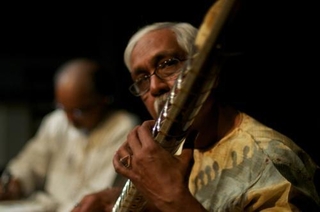Fellows Reflection: Rabindra Goswami

The Christian Raga Project
My Christian Raga project is based on the music I have observed, sung, and played at different churches. I have visited a variety of them, including Catholic, Episcopalian, Evangelical, Lutheran, and Presbyterian ones, as well as Marquand Chapel. During services in these churches, one hears numerous hymns, and these are often given accompaniment by musical instruments. In Orthodox churches, however, one hears only chanting, and this is performed without any accompaniment.
Music, to be sure, is an important part of these services. Music in the church has a long history, and we know about the importance of music for the church from many sources. For example, consider Psalm 150: verses 1–6.
Praise the LORD!
Praise God in his sanctuary;
praise him in his mighty firmament!
Praise him for his mighty deeds;
praise him according to his surpassing greatness!
Praise him with trumpet sound;
praise him with lute and harp!
Praise him with tambourine and dance;
praise him with strings and pipe!
Praise him with clanging cymbals;
praise him with loud clashing cymbals!
Let everything that breathes praise the LORD!
Praise the LORD!
There are numerous parallels with the music in India, where trumpets, lutes, harps, tambourines, strings, and pipes are also used to praise God. And in
Indian devotional music we find many “clanging and clashing cymbals,” particularly in those hymns known as bhajans.
Nevertheless, most of the musical styles in India are based on ragas, which can be thought of as chromatic scales. “Raga” in the Indian context is often defined as a special sound with numerous embellishments that elevates the human mind. In practice, however, ragas involve a strict set of rules for making these chromatic scales comes to life. Ragas are defined by mood—they can be happy, melancholy, sensuous, meditative, and so on—and when they are played properly these moods are instilled in the listener. Raga music, in other words, is mood music.
The raga tradition also tells us that sound itself is divine. God, in other words, is also sound. And so raga music is really divine mood music. This means that the practitioner of raga music, whether a vocalist or instrumentalist, must always bear in mind the worship of the divine.
Ragas—in the sense that they are moods—can be expressed through music, but they can also be expressed through poetry and painting. The latter, known as ragamala paintings, show the mood of the raga through image as opposed to sound. Let me offer two examples.
- Raga Hindola
- Raga Gunkali
My project, as most of you know, involves using the techniques of raga music to create Christian moods. My goal is to use the discipline of raga music and the idea that sound itself can be divine to make Christian ragas.
To put it another way, the goal is to translate some of the moods associated with Christian divinity into the language of raga music and to play this on my sitar. The first Christian raga I have composed is based on the chanting I have heard at an orthodox church. Hence, I call this Raga Ortho.
This raga is based on the Indian scale known as Bilawal, which is major scale. It repeats the series of notes that correspond in the chanting to “Lord Have Mercy” and “Hallelujah.” My goal here isn’t to mimic the chanting, but to use the tune, themes, key changes, and intervals as a kind of inspiration and guide.
The second Christian raga I have composed is based on Taize, which I first heard sung here at the Marquand chapel. I call this Raga Taize. The notes used are as follows:
Ascending: Do Re Me Re Do Fa So La Ḋo (octave)
And descending: Ḋo Las So Fa So Me# Fa Me Re Do
And it included these phrases: Do Me Re Sị Re Do Do Fa.